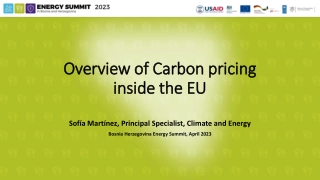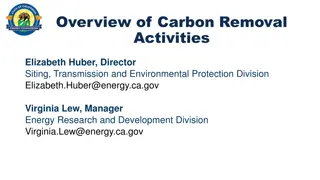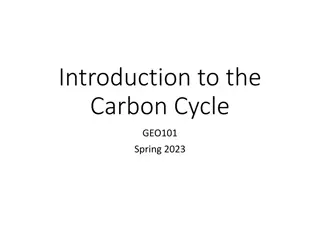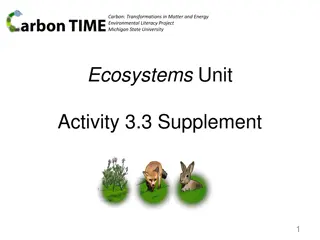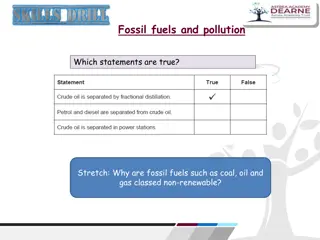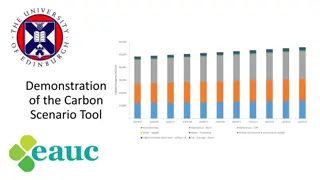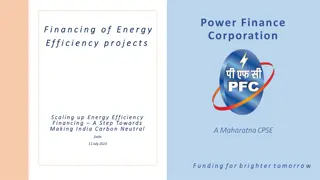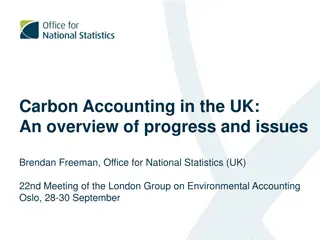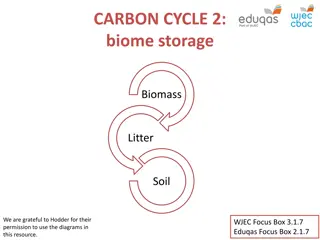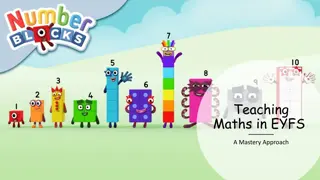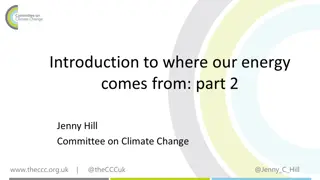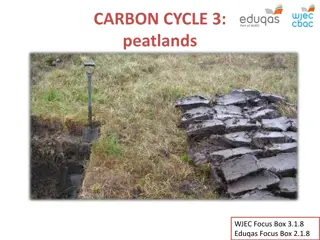
Offset Your Household's Carbon Footprint with Smart Solutions
Discover how to make households and businesses carbon neutral by offsetting their carbon footprint through options like planting trees, supporting reforestation projects, investing in renewable energy, and more. Explore cost-effective ways to reduce CO2 emissions and contribute to environmental sustainability.
Download Presentation

Please find below an Image/Link to download the presentation.
The content on the website is provided AS IS for your information and personal use only. It may not be sold, licensed, or shared on other websites without obtaining consent from the author. If you encounter any issues during the download, it is possible that the publisher has removed the file from their server.
You are allowed to download the files provided on this website for personal or commercial use, subject to the condition that they are used lawfully. All files are the property of their respective owners.
The content on the website is provided AS IS for your information and personal use only. It may not be sold, licensed, or shared on other websites without obtaining consent from the author.
E N D
Presentation Transcript
SS1 Offset your household s footprint You can reduce your carbon footprint but it s impossible to reduce it to zero. So how do households and businesses become carbon neutral? Offsetting options 1. Plant trees Cost: 12.50 to offset 1 ton of CO2 Each tree will remove CO2 from the atmosphere. The trees can be planted near schools, to educate children and support habitats. 2: Reforestation Cost: 10.00 to offset 1 ton of CO2 Your funding supports the planting of trees in the Great Rift Valley in Kenya. The project employs local people. By offsetting your carbon footprint. It means doing something to remove all the CO2 your actions produce. Either you can do it, or you pay a company to do it for you. What to do: 1. Recall your household s carbon footprint (after actions), which you calculated earlier. 2. Look at the six options to offset your carbon footprint. Think about: - the economic consequences (how much they cost). - The social consequences (how they affect people). - The environmental consequences (how they affect habitats). Choose a mix of at least two options. 3: Pay a carbon capture plant Cost: 60 to offset 3 tons of CO2 You will pay a carbon capture plant in Iceland to remove CO2 from the air. The plant pumps the gas underground where it will slowly become stone. 4: Give households a cookstove Cost: 30 to offset 2 tons of CO2 Your money will give people in Malawi energy-efficient cookstoves to use instead of open fires. They use less firewood and emit less dangerous fumes. 3. Write your recommendations and present them to your household.: We can offset ...tons of CO2 at a cost of ... The options I recommend are I chose these because 6: Invest in a wind farm Cost: 15.00 to offset 2 tons of CO2 Your funding will help build a new wind farm in Panama. Wind power will provide communities with electricity without releasing any CO2. 5: Protect the rainforest Cost: 100 to offset 4 tons of CO2 Your funding will help to protect an area of rainforest in Brazil against deforestation, preserving this high biodiversity habitat. 4. Discuss this question together. Should every household offset their footprint. Why or why not? Student sheets
SS2 Help Coffee Club become carbon neutral 3. Write your recommendations Here's what to include. We really care abut the planet and want to be carbon neutral, but we don t want to spend too much money. So, we are hiring carbon consultants to recommend what to do. Introduction What a carbon footprint is. The caf s current carbon footprint. What carbon neutral means. Why it is important to be carbon neutral. Rose the caf owner You are a team of carbon consultants . You want to be chosen by the caf to reduce their carbon footprint from 15 tons to 0. To do this, you will make your recommendations and present them to the owner. Middle Actions What actions you think the caf should take. The total initial and yearly costs. Persuasive reasons to choose these actions (economic, social and environmental). Here is what to do: Resources to use: 1. How to reduce the footprint There are three problems: transport, electricity and waste. Each has three possible actions. Discuss the choices and choose one action for each problem. Calculate total initial cost and yearly cost. Add up how much CO2 the actions will save. Do your choices reduce the caf s carbon footprint to 0? If not, you need to change your choices. SS4-6 from the Choose actions activity Offsetting What carbon offsetting is. What offsetting the caf should use. The yearly cost. Persuasive reasons to choose this offsetting (economic, social and environmental). SS2: Action costs and savings 2. How to offset the footprint Choose which carbon offsetting to use to get to carbon neutral. Calculate the cost per year. SS1: Offset your footprint Conclusion Why this is the best plan for the caf . Why the owner should hire your team.
SS3 Action costs and savings SS3 Action costs and savings Problem: Transport Problem: Transport Action 1: Use public transport Action 1: Use public transport Action 2: Buy bikes Action 2: Buy bikes Action 3: Buy local Action 3: Buy local Initial cost: 0 Cost per year: 0 CO2: -0.6 tons/year Initial cost: 0 Cost per year: 0 CO2: -0.6 tons/year Initial cost: 500 Cost per year: 0 CO2: -1.3 tons/year Initial cost: 500 Cost per year: 0 CO2: -1.3 tons/year Initial cost: 0 Cost per year: 600 CO2: -1.1 tons/year Initial cost: 0 Cost per year: 600 CO2: -1.1 tons/year Problem: Electricity Problem: Electricity Action 3: Install solar panels Action 1: Increase efficiency Action 1: Increase efficiency Action 3: Install solar panels Action 2: Change provider Action 2: Change provider Initial cost: 5000 Saving per year: 800 CO2: -1.6 tons/year Initial cost: 3000 Saving per year: 120 CO2: -1.0 tons/year Initial cost: 3000 Saving per year: 120 CO2: -1.0 tons/year Initial cost: 5000 Saving per year: 800 CO2: -1.6 tons/year Initial cost: 500 Cost per year: 180 CO2: -1.4 tons/year Initial cost: 500 Cost per year: 180 CO2: -1.4 tons/year Problem: Waste Problem: Waste Action 3: Donate food waste Action 1: Recycle more Action 2: Sell reusable cups Action 1: Recycle more Action 2: Sell reusable cups Action 3: Donate food waste COFFEE CLUB COFFEE CLUB Initial cost: 0 Cost per year: 0 CO2: -0.2 tons/year Initial cost: 0 Cost per year: 720 CO2: -0.8 tons/year Initial cost: 0 Cost per year: 90 CO2: -0.4 tons/year Initial cost: 0 Cost per year: 720 CO2: -0.8 tons/year Initial cost: 0 Cost per year: 90 CO2: -0.4 tons/year Initial cost: 0 Cost per year: 0 CO2: -0.2 tons/year
Assessment checklist SS4 Award each content item a mark out of 3, where 3 means it was fully covered. Persuasive arguments should include a number of different economic, environmental and social consequences. Section Content Group 1 Group 2 Group 3 Group 4 Group 5 Group 6 Introduction Carbon footprint explained Carbon neutral explained Explanation about why being carbon neutral is important Actions Three actions presented with costs Achieves carbon neutral Persuasive arguments about why to choose them Offsetting Offsetting explained Recommendations given with cost per year Persuasive arguments about why to choose them Conclusion Persuasive plea to choose their plan Total for presentation (mark out of 30)


